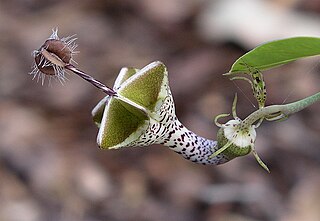
The Asclepiadoideae are a subfamily of plants in the family Apocynaceae. Formerly, they were treated as a separate family under the name Asclepiadaceae, e.g. by APG II, and known as the milkweed family.

Ceropegia is a genus of plants within the family Apocynaceae, native to Africa, southern Asia, and Australia. It was named by Carl Linnaeus, who first described this genus in his Genera plantarum, which appeared in 1737. Linnaeus referred to the description and picture of a plant in the Horti Malabarici as the plant for which the genus was created. In 1753 he named this species as Ceropegia candelabrum. Linnaeus did not explain the etymology but later explanations stated that the name Ceropegia was from the Greek word keropegion κηροπηγɩον. This means candelabrum in Latin, which has a broader range than the modern word - "a candlestick, a branched candlestick, a chandelier, candelabrum, or also lamp-stand, light-stand, sometimes of exquisite workmanship".

Hoya is a genus of over 500 accepted species of tropical plants in the dogbane family, Apocynaceae. Most are native to several countries of Asia such as the Philippines, India, Thailand, Malaysia, Vietnam, Bangladesh, Indonesia, Polynesia, New Guinea, and many species are also found in Australia.

Stapeliinae is a subtribe of flowering plants within the tribe Ceropegieae of the subfamily Asclepiadoideae of the family Apocynaceae. The subtribe comprises about 35 genera, including both the stem-succulent "stapeliads" and the horticulturally popular genera Brachystelma and Ceropegia. The largest number of genera are native to Africa, but a more limited number of genera are widespread in Arabia and Asia. Historically, a similarly circumscribed taxon was treated as a separate tribe, Stapelieae.

The genus Huernia consists of perennial, stem succulents from Eastern and Southern Africa and Arabia, first described as a genus in 1810.
Pachypodium bicolor is a species of plant in the family Apocynaceae.

Ceropegia stapeliiformis is a flowering plant in the genus Ceropegia (Apocynaceae), native to South Africa and Eswatini. Common names include serpent ceropegia, snake creeper, and slangkambro.

Duvalia is a succulent plant genus in the subfamily Asclepiadoideae, in the family Apocynaceae (dogbane).

Cynanchum viminale is a leafless succulent plant in the family Apocynaceae. The species is native to West Africa, the Indian Ocean and Western Pacific region. The species' natural range extends from South Africa throughout much of Africa and the Middle East to India, Indochina, Southern China, Indomalaya and into Meganesia. The species is also found on several Indian Oceans islands including Mauritius, Réunion and the Seychelles.

Tabernaemontana crassa is a plant in the dogbane family Apocynaceae, native to tropical Africa.
Ceropegia striata is a plant species endemic to Madagascar. It is known only from the Vavavato Massif in the central highlands, at an elevation of approximately 1800 m.

Pseudolithos is a genus of succulent flowering plants of the family Apocynaceae, indigenous to arid areas of Somalia, Yemen and Oman.

Echidnopsis is a genus of succulent, cactus-like plants in the family Apocynaceae, first described as a genus in 1871. They are native to eastern Africa and the Arabian Peninsula.

Fockea multiflora, or python vine, is a plant of the dogbane family, Apocynaceae, native to Tanzania, Mozambique, Zimbabwe, Zambia, Angola, Botswana, Namibia, including the Caprivi Strip, and Malawi. It is a large semisucculent liana, growing to some 15m in length and up to 60 cm in diameter, found primarily in the seasonally dry tropical biome.

Ceropegia candelabrum is the type species in its genus of plants, belonging the subfamily Asclepiadoideae. The Latin specific epithet candelabrum is derived from the candelabra-like appearance of the inflorescences.
Vincetoxicum lineare is a species of plant in the family Apocynaceae native to Australia. Known as the bush bean, it is an edible species of plant found in arid regions. As Rhyncharrhena linearis, the species was at one time the only species in the monotypic genus Rhyncharrhena.

Duvalia elegans is a small succulent plant species, in the family Apocynaceae. It is the type species of the genus Duvalia, and it is endemic to the Western Cape Province, South Africa.

Duvalia vestita is a small succulent plant species, in the family Apocynaceae, indigenous to the southernmost part of the Western Cape Province, South Africa.

Larryleachia perlata is a species of flowering plant the family Apocynaceae. The species is a succulent plant species. The species is considered an insufficiently known species.

Ceropegia ampliata is a flowering plant in the dogbane family Apocynaceae, native to eastern and southern Africa, including Kenya, Tanzania, Mozambique, South Africa, Eswatini, Botswana, and Madagascar. Common names include bushman's pipe, condom plant, and horny wonder.



















